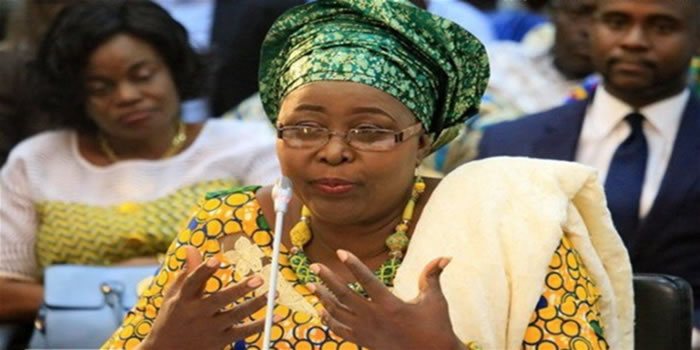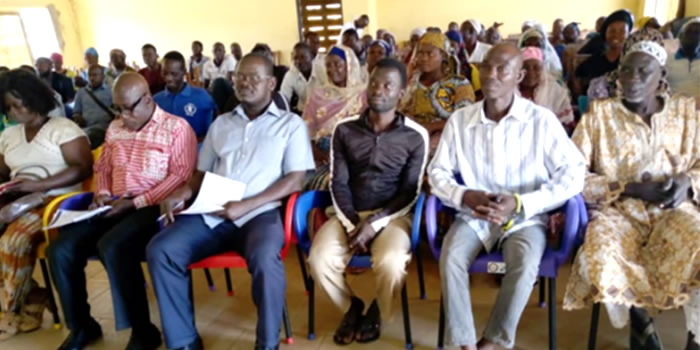

District Economy
A formidable micro economy of the District is vital for the reduction of extreme poverty. This seclion is therefore devoted to the analysis of the structure of the District’s economy, household income and expenditure patterns as well as revenue and expenditure status, economic infrastructure and commodity export.
Structure of the Local Economy
The economy of the District is dominated by agriculture with commerce and industrial sectors least developed. Agriculture accounts for about 68% of the District labour force, commerce account for about 12%, while industry and other sectors account for about 20%.
House Income and Expenditure
The annual average household income for a sampled population of 900 households is 05,200,000.00. The average per capita income was realized to be 0604,651. Most of the people draw their income food crop farming (57.2%) and other businesses 42.8%. With this high dominance of food crop farming as a source of the household income in the district, which is largely rain fed, there is the need for the development of irrigation facilities that will constantly supply water to reduce the degree of vulnerability associated with rain failures.
The mean annua! household expenditure for the District was 05,402,000.00 per annum giving an average monthly expenditure of 0450,167.00. The gap between the household income and expenditure represents non-costed consumption expenditure; basically on food items. Further analysis of the household expenditure revealed that most households in the District spend about 60% of their incomes on household needs such as food, clothing and energy.
Saving
Saving is an important part of the District’s economy since it is the mechanism for accumulating capita! for investment. The survey however revealed that the culture of saving is too low. Out of a total of 900 sampled households about 82% did not save any thing. This is probably due to the low incomes coupled with high demand for household needs.
Levels of poverty
The District adopted a World Bank definition of poverty for this analysis. By this, two lines of poverty were identified.
The ’poverty line’ which defines the population earning less than two thirds of the average income for the District.
The Hard Core line which defines the population earning less than one third of the average income. According to this definition, it can be said the population within the poverty lines is deprived of their basic needs and demand special attention, those within the hard core line however require urgent attention.
In estimating average income, the District adopted the median as a measure of average due to the skewed nature of income distribution in the District. With the district average annual household income standing at 05,200,000.00. tiie two lines of poverty based on the calculation of the annual household income stands at 01,733,333 (hard core poverty) and 03,466,667 (for poverty line). Depending on these estimates the level of poverty and hard core poverty is estimated at 32 per cent and 16 percent of the district respectively
District Finance
This section of the plan deals with the analysis of revenue and expenditure of the District from 2004-2005. This is to assess the performance of various revenue and expenditure components since the creation of the District. It is intended to inform the recommendations to be made in order to improve the performance of the District’s finance. It further analyses key areas in both revenue and expenditure that will require prompt attention if substantial financial allocations from the District’s own resources to new development projects are to be made, figures for the revenue and expenditure for the period under review in this section have not been discounted to reflect real change.
Therefore the basic assumption is that changes in most of the rates charged over the years (2) are manifestations of inflationary changes in the country over the period.An analysis of the District revenue sources indicates that market tolls are the major contributor to the Internally Generated Revenue. It contributed about 76.78% of the internal revenue in 2004 and 67,88% in 2005, This item grew by 84 % within one year. Further analysis of market tolls in the District revealed that most of the market tolls are generated from the Dambai market and the performance is expected to increase by more than 100% if attention is paid to the other markets. This underscores the importance of markets in the District’s Development as a major source of revenue. In spite of the encouraging performance of market tolls significant issues need to be addressed if it is to remain the major contributor:
- Poor development of market infrastructure
- Inadequate trained revenue collectors
- Poor supervision and monitoring of revenue collectors
- The major source of funds to the District is from external sources. The most important of these to the financing of capital projects in the District is the District Assembly Common Fund. This implies that the timely and sustainable disbursement of the Common Fund is a key factor in the District development. Other external sources include GETFUND, HI PC funds MS HAP and donor funds
Expenditure
The expenditure side of the District’s Budget has been divided into Recurrent and expenditure to conform to the conventional budget structure of Local Governance in Ghana. As can be noticed in the table below Personnel Emolument was the highest recurrent expenditure item accounting for about 3.0% of expenditure for 2005. Development projects account for about 91.73% of the total budget for 2004 and 93.15% of the budget for 2005. This means that most of the funds received by the District are spent on development projects.
Investment and Business Potential
Agriculture is the key economic sector and the district is a leading producer of citrus and coconut in the region. These, in particular, hold huge potential for private investors willing to establish modern plantations, since demand for these crops is high and distribution networks to other parts of the country have been well established. Other crops cultivated are oil palm and pineapples. The former is a major input for soaps and the latter is of export quality. Cocoa and coffee, also export crops, are cultivated on a small scale but there are no constraints to larger production, if an investor opts to do so. Food crops grown are cassava, yams, plantain, cocoyam, banana and maize.
Vegetables include tomatoes, garden eggs, cabbages and pepper. The Edumfa and Abeka areas in the district are the major producers of cassava, maize, oranges and oil palm. All these crops have strong markets, both locally and internationally. Importantly, productivity is very high. The average farm acreage is between two and 20 acres per farmer. Oil palm farmers have the largest acreage on the average of 15.3, followed by lime farmers at 10.1 and orange farmers at 8.5.Farmers engaged in cocoa and cassava, have, on the average, farm sizes of 7.2 acres. Fishing is the biggest activity in this district. Moree lands about 2,000 tonnes of fish monthly at its local fishing harbour.
This industry, however, is seriously hindered by the lack of cold storage facilities in the area. Therefore, huge potential is available for private investors setting up cold storage facilities, which, in turn, would create even more opportunities in the area of fishing itself. Livestock production, such as cattle ranching and poultry, is low-keyed in the district. However, this takes nothing away from the sheer potential such an activity has. There is only one medium scale processing industry in the district now.This is Fruit and Flavour Limited, located at Asebu. The company is involved in the processing of lime for export and its source of raw materials comprises the small-scale citrus farmers in the district.
Considering this company’s ongoing successes, the size of the export market for lime and the upwardly elastic nature of local supply levels, the area can easily support another equally profitable venture of this nature. There is a small stone quarry at Abakrampa, a small-scale citrus industry at Nyamedom and two sawmilling factories at Abura-Dunkwa and Edumfa. These areas hold plenty of opportunities for industrial enterprises, given their proximity to sources of useful raw material supplies, and the abundance of cheap labour. To bring out their full potential, the District Assembly intends to establish industrial estates and provide the needed infrastructure and services in the major towns of Abura-Dunkwa, Abakrampa and Asebu.
This will significantly boost industrial development. There are also some traces of mineral deposits in the district which are yet to be exploited. These include kaolin and feldspar at Mpesednedze and Abenu. Clay deposits exist at Bosonim and rock quarrying at Tetse and Miense. The District Assembly will welcome private investors interested in exploiting these mineral deposits in an environmentally-friendly way.
Indeed, the Abura-Asebu-Kwamankese District is brimming with opportunities and the District Assembly is committed to private sector-driven growth for the area, both through direct productive enterprises and private sector funded and managed infrastructure. In contrast to development problems and constraints, which are likely to provide positive impact on the achievement of set goals, the following factors are identified as catalyses on development in the Districts:
Large body of surplus unskilled labour that can be tapped by investors;
Existing of a fish-class Fosu-Cape Coast Highway. Passing through north-southwards and Tetsi-Ayeldu-Mankessim asphalt all-year road, making the settlements along their corridors highly accessibly to other parts of the country.
Presence of water bodies, including a remarkable natural spring, Mankensu.
Possible availability of land for cultivation of both arable and tree crops as in the case of Apanga Apex Ltd.
Large deposit of Kaolin near Tetsi-Mankessim highway;
Presence of agro and forestry produce for processing;
Sea-front, though shorts, exists for marine fisheries.
Existence in the District of the Asuansi Technical Institute and the Farm Institute for active involvement in the development process through the Agricultural Extension Service.
Recommendation
Given its problems, constraints and potentials, the development of the Abura-Asebu-Kwamankese District would be accelerated if planned and woven around the following themes:
Mobilisation of local financial resources for development;
Efficient use of productive resources;
Harnessing human resources for gainful employment;
Increased spatial interaction for social equity without endangering but rather promoting and
Sustaining the quality of the environment of the District'
From the extensive interviewing of a cross-section of the citizenry, the following emerged as the goals for the District as felt by the respondents in order of importance:
Increase gainful employment of human and other given resources;
Increased generation of household cash incomes;
Revenue resources mobilisation;
Increase in availability of invertible capital; - Reduction of harvest losses;
Improvement in the quality of road network;
Improvement in health delivery system;
Decisive improvement in sanitary conditions;
Reduction in environmental degradation;
Promotion of the application of Science and Technology interestingly, these felt goals are not inconsistent with national goals as set out in Ghana-Vision 2020. In this connection, there was the strong feeling that these goals be reflected in the future in the selection of development projects and programmes for consideration in the next Multi-Year Development plan of the District.
POCC
Potentials, Opportunities, Constrains and Challenges
The development problems identified during the socio-economic survey were subjected to Potentials, Opportunities, Constraints and Challenges - POCC analysis for meaningful interventions.
Financial Institutions
Banking
There are five banks located in three major towns all along the Fosu-Cape Coast highway corridor. At Abura Dunkwa are the Ghana Commercial Bank Ltd., the oldest in the District, the Akoti Rural Bank, Ltd., and the Nyankumasi Ahenkro Rural Bank Ltd. At Moree are located the Kakum Rural Bank, Ltd. and the Mfantseman Rural Bank Ltd. at Abakrampa is located the sixth bank, the Kakum Rural Bank Ltd.
Besides other Banking services which it renders to the community, the Ghana Commercial Bank Ltd, provides the special services of the encashment of salaries of public servants working in the District as well as those of pensioned civil servants. Using salaries as collateral, the Ghana Commercial Bank provides short-term loans to civil servants working in the District
The Rural Banks are essentially Mobilization Centres for their parent Banks but also provide loans to their customers. Because of its worldwide connections, the Ghana Commercial Bank receives considerable transfers (which are usually deposited with the Bank) from many relatives living outside Ghana. These transfers are usually donations, gifts and remittances for the acquisition of urban land and construction of houses. The Ghana Commercial Bank Ltd. is also the main banker of the District Assembly.
Date Created : 11/10/2017 7:46:17 AM









 facebook
facebook
 twitter
twitter
 Youtube
Youtube
 +233 593 831 280
+233 593 831 280 0800 430 430
0800 430 430 GPS: GE-231-4383
GPS: GE-231-4383 info@ghanadistricts.com
info@ghanadistricts.com Box GP1044, Accra, Ghana
Box GP1044, Accra, Ghana